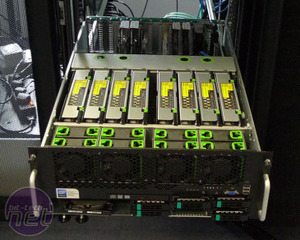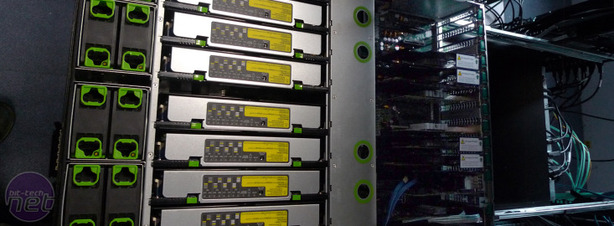Workstation applications
Workstation applications historically haven't scaled much beyond eight threads, although that's now beginning to change. However, what hasn’t changed is that workstation applications such as 3D rendering and modelling packages are still very sensitive to the IPC (instructions per clock) and clock frequency of the CPU(s) they are being run on.As expected the Xeon X7560 system didn’t perform well at all in the Cinebench R10 test. This is because this test only scales to 16 threads, and each execution unit in the Xeon X7560s is clocked at a lowly 2.26GHz – much slower than most modern workstation CPUs.
In contrast, the Xeon X7560s were able to obtain pole position in the updated version of Cinebench, R11, as this test does scale better, although it’s still limited to a maximum of 32 threads. That said, we still wouldn’t recommend using a quad-processor system for this type of workload, as most rendering apps, such as Cinema 4D, on which Cinebench is based, support network rendering, as a cluster of dual-processor systems could achieve the same render time at a far lower hardware and power cost.
The Xeon X7560s also performed very poorly in LightWave 9.6, with the slowest render time we’ve seen on any SMP system in recent years. Once again this is no surprise though as LightWave is known to love high frequency CPUs as opposed to dozens of cores.
HPC/server applications
Terragen 2 is by nature a graphics application so most people would traditionally think of it as a workstation application. However, given its computationally intensive nature we tend to think of it as a HPC (High-Performance Computing) application.
so most people would traditionally think of it as a workstation application. However, given its computationally intensive nature we tend to think of it as a HPC (High-Performance Computing) application.However, despite Terragen 2 rendering on all 64 execution units the Xeon X7560 system was still unable to claim first place, taking 7 seconds longer than a pair of far cheaper Xeon X5650s.
CFD remains one of the most computationally intensive tasks you can throw at a workstation/server, so it came as no surprise to us when the Xeon 7560 absolutely demolished the Euler3D CFD benchmark with a record breaking score of 16.596GHz. In contrast, the next fastest system, a pair of Xeon X5650s scored just 8.903Hz, less than half the score. Clearly if you do any sort of CFD simulations, such as those run by engineering and architectural design houses, a system with four Xeon X7560s will be far more responsive than any other hardware.
The Xeon 7560’s also took the lead in the FlamMap fire behaviour and analysis benchmark with a graph leading score of 110 seconds. However, this is only 9 seconds faster than a pair of Xeon X5650s, so despite FlamMap scaling across all 64 threads, clearly this applications isn’t entirely suited to running on a quad-processor server.
Biological/atomic simulations such as Folding@home are a great way of getting results back far quicker than conducting experiments in the real world. As these sorts of simulations scale very well across multiple cores we knew the quad of Xeon X7560s would perform very well, but even we were astonished to see each frame of a bigadv work unit in our folding benchmark being finished in just over 12 minutes with a resulting score of 114,958ppd. To put this into context, the next fastest system comprised a pair of Opteron 6174s, which completed each frame in an average of 18 minutes and two seconds, with a resulting score of 62,792ppd. Better, still the quad of Xeon X7560s absolutely demolished the previous-generation Xeon X7460s, which took just over 22 minutes to fold a frame, with a resulting score of 46,231ppd.
Synthetic tests
Unfortunately, the Xeon X7560 system crashed every time we tried to run the 32-thread version of the Stream memory benchmark on it, so we were forced to use the 16-thread version instead. Although this is the same version we ran on the pair of Opteron 6174s and Xeon X5650s, the Xeon X7560 still performed far worse, with on average less than half the memory bandwidth of the Opteron system. However, given that both systems have such a similar memory architecture (quad-channel DDR3) we’re not entirely convinced these numbers are reflective of real-world performance, and are currently talking to AMD and Intel about why Stream is giving these results.The 32M test in WPrime also gave a very unexpected result on the Xeon X7560 system, with a appalling score of 12.558 seconds, close to four times worse than we had expected to see. It’s hard to draw any conclusions from this result, as clearly there is some sort of conflict between the hardware and software that Intel and WPrime need to address.
Power consumption
Currently, we don’t have any other quad-processor servers in our test lab, so the power consumption figures for the Xeon X7560 system do really stand out from the dual-processor systems also on the graph. For example, at load the Xeon X7560 guzzled 1.13kW from the mains, just over four times as much as any of the dual-processor systems. The Xeon X7560 was even less energy-efficient when idle, drawing 638W from the mains, versus just 143W from the least power-efficient dual-processor system.
The 4U server that we used to test the Xeon X7560s; the front of the case is dominated by the eight hot-swappable fans and eight hot-swappable memory daughtercards. Click to enlarge.
Conclusion
It’s hard to draw a solid conclusion on the Xeon X7560 and Nehalem EX in general with so little comparative data to analyze. In theory for example, AMD’s brand new Opteron 6000-series does also support four CPUs in a single server, but as yet, no quad-socket motherboards have been seen in the wild.What’s clear though is that despite the massive performance boost provided by moving from the ageing Core 2 to Nehalem architecture, the Xeon 7500-series is far from suitable for all professional systems. In fact we’d say that even in a dual-processor configuration, a pair of Xeon X5600-series CPUs will deliver far greater performance in most workstation applications, cost less to buy and cost far less to run too.
Even for the server market, the Xeon 7500-series is a very specialist product, and so is only worth investigating if you’re workloads scale very well across multiple cores, but cannot be distributed across multiple servers. Folding@home for example ticks both these boxes, but as multiple dual-processor servers would be cheaper than one quad-processor Xeon 7500-series server, you’d be far better off running the former.
That said, there will undoubtedly be some users, such as those running huge financial models, which will really benefit from the brute processing power delivered by four Xeon 7500-series CPUs. After all, cramming 64 execution units and up to 1TB of RAM in a 4U unit running a single OS is a great step forward for the server market, especially as the folding benchmark revealed, the Xeon 7500-series is so much faster than the previous-generation Xeon 7400-series.
Intel Xeon X7560
- Performance
- x
- x
- x
- x
- x
- x
- x
- x
- -
- -
- 8/10
- Value
- x
- x
- x
- x
- x
- x
- -
- -
- -
- -
- 6/10
- Overall
- x
- x
- x
- x
- x
- x
- x
- -
- -
- -
- 7/10

MSI MPG Velox 100R Chassis Review
October 14 2021 | 15:04









Want to comment? Please log in.